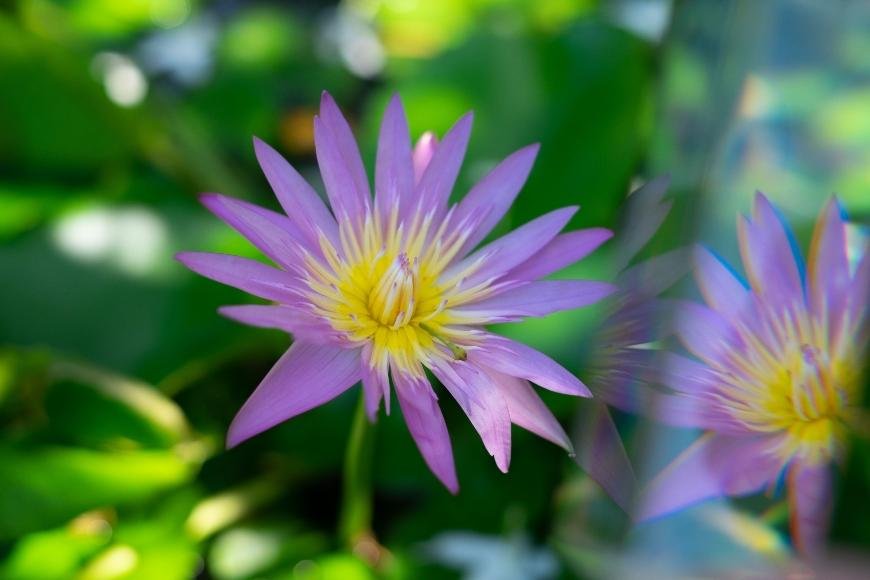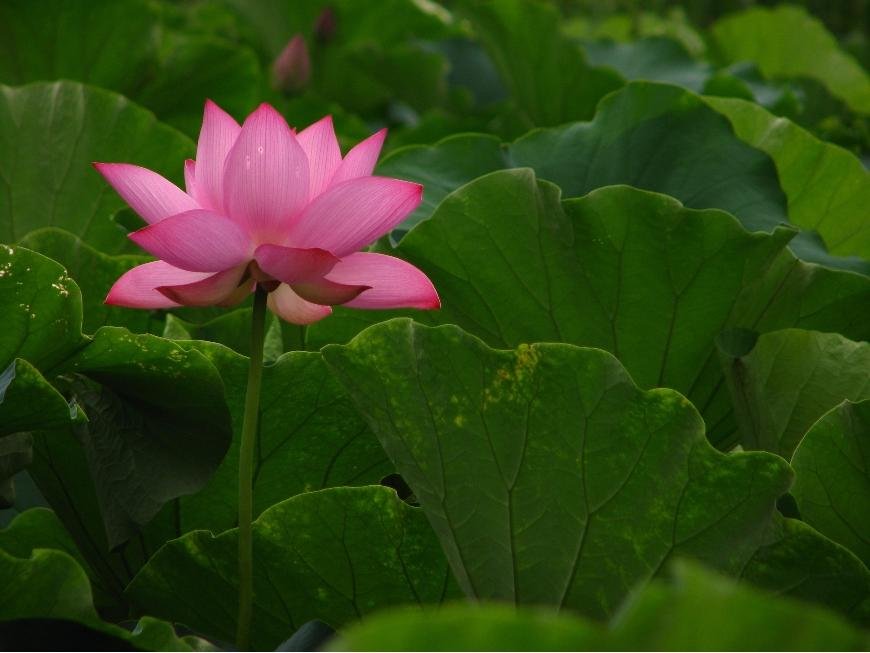How to Grow Pink Lotus
Learn how to grow pink lotus with our beginner's guide, covering planting, care, pest control, and harvesting tips for beautiful water garden plants.

Picture this: you're on a quest to grow lotus, specifically the stunning pink variety.
You've heard about the beauty and symbolism of these sacred flowers, but also their potential recreational uses. Intrigued, you decide it's time to learn how to grow pink lotus yourself.
But where do you begin? You need guidance from someone who knows the ins and outs of growing lotuses – an expert in cultivating these perennial plants.
Well, look no further. This blog post will provide all the information needed for successfully growing pink lotus flowers in your own water garden or pond.
We'll cover everything from choosing the right location for your plants to planting techniques, caring for them throughout their growth cycle, harvesting methods, and even storage tips.
Dive into this comprehensive guide on how to grow pink lotus and discover not only a rewarding hobby but also its many fascinating uses!
Table of Contents:
- Choosing the Right Location
- Planting and Caring for Pink Lotus
- Controlling Pests and Diseases
- Harvesting Pink Lotus
- Preparing the Harvested Pink Lotus
- Storing Pink Lotus: Keep It Fresh and Flavorful
- Exploring the Versatility of Pink Lotus: Various Uses
- Conclusion
Choosing the Right Location
When it comes to growing pink lotus plants, finding the perfect spot is crucial.
Consider important factors like sunlight, temperature, and soil type when selecting a location for your new addition to your psychedelic garden.
Let me break it down for you:
Sunlight
Pink lotuses love basking in the sun.
Make sure your chosen spot receives at least 6 hours of direct sunlight daily to ensure optimal growth.
Temperature

The ideal climate for these beauties is warm and humid, with temperatures between 75°F (24°C) and 86°F (30°C).
If you live in colder regions, don't worry - just make sure to provide some extra care during the winter months or grow them indoors using a heated pond setup.
Soil Type
Pink lotuses aren't too picky about their soil but prefer nutrient-rich loam or clay substrates that retain moisture well.
- Avoid sandy soils since they can cause poor root development and hinder plant growth.
- Add organic matter such as compost or aged manure if needed to improve soil quality.
- Maintain a slightly acidic pH level between 6.0-7.0 for best results.
By following these tips, you'll be well on your way to growing beautiful pink lotus flowers.
Planting and Caring for Pink Lotus
Are you ready to dive into the exciting world of pink lotus cultivation? Let's get started.
The first step is to find a container or pond to grow your lovely aquatic plant. Once you have that, follow these steps:
- Fill the container with nutrient-rich soil, about 6 inches deep.
- Gently place your pink lotus tuber in the soil.
- Cover the tuber with more soil, around 3 inches, but be careful not to bury the growing tips.
- Add water slowly until it covers the soil by about 4 inches. This will create an ideal environment for growth.
Now that your pink lotus is planted, it's time to take care of it. Here are some essential pointers:
- Sunlight is key: Pink lotus plants need at least 6 hours of sunlight per day to thrive.
- Fertilize monthly: During the summer months, fertilize your pink lotus plant once a month to promote healthy growth.
- Pond maintenance matters: Keep your pond clean and clear from debris to prevent any pests or diseases from affecting your pink lotus.
- Prune as needed: Gently prune yellowed leaves or spent flowers as needed to keep your pink lotus looking its best.
If you follow these steps carefully, you'll soon have a thriving pink lotus in no time. And if you're ready for more, consider adding other water plants like water lilies to your pond or container. With a little care and attention, you can create a beautiful underwater garden in your backyard.
Now that you know how to grow pink lotus, it's time to get started. Happy planting.
Controlling Pests and Diseases
Let's face it, no one wants uninvited guests crashing their pink lotus party. To keep your plants healthy and thriving, you need to tackle those pesky pests and diseases head-on.
Here are some common culprits and how to deal with them:
Aphids
Aphids, the tiny green or black insects that love sucking plant sap, can be a real nuisance for your pink lotus. To get rid of these freeloaders, try spraying your plants with a mixture of water and mild dish soap or use an organic insecticide like neem oil.
Fungal Infections
Your precious pink lotus may also fall victim to fungal infections such as leaf spot or root rot. To prevent this from happening, ensure proper air circulation around the plant by removing any dead leaves promptly and avoid overwatering - soggy soil is a fungi magnet.
Natural Predators
Mother Nature has her own way of dealing with pests - natural predators. Ladybugs will happily munch on aphids while frogs feast on slugs that might damage your beautiful blooms. Attract these helpful critters to your garden by planting flowers like marigolds or providing a small pond for frogs.
Maintaining Plant Health
Remember, prevention is better than cure. A healthy pink lotus plant can better resist pests and diseases, so ensure you're providing the right nutrients, water, and sunlight. If you notice any signs of trouble brewing such as yellowing leaves or stunted growth, act quickly to address the issue before it gets out of hand.
Harvesting Pink Lotus
Alright, green thumbs, it's time to reap the rewards of your hard work. Knowing when and how to collect the blooms of this gorgeous flower is essential for reaping its full benefits. So let's dive into the nitty-gritty details on harvesting these aquatic gems.
When to Harvest
The best time to harvest pink lotus is during its blooming season, which typically falls between June and September. Keep an eye out for fully opened flowers with vibrant colors and a pleasant fragrance - that's when they're at their prime.
How to Harvest
- Step #1: Start by carefully approaching your pink lotus plants in a shallow water area or using a specialized tool.
- Step #2: Gently grasp the flower stem close to its base while supporting it with your other hand.
- Step #3: Using sharp scissors or pruning shears, make a clean cut just above where the stem meets the main stalk of the plant (about 1-2 inches).
- Step #4: Carefully lift and remove the harvested flower from its watery home without damaging any surrounding foliage or roots.
Presto. You've successfully harvested your very own pink lotus flowers. Don't let the leaves and seeds go to waste, as they can also be harvested for various uses.
Now that you've got your harvest, it's important to learn how to prepare and store these beauties properly.
Preparing the Harvested Pink Lotus
Alright, let's dive into preparing your freshly harvested pink lotus.
This process is essential to ensure you get the most out of your harvest for various uses like cooking or crafting.
So, here are some simple steps to follow:
Step #1: Start by rinsing off any dirt or debris from the petals and leaves using clean water.
Step #2: Gently dry them with a paper towel, being careful not to damage their delicate structure.
Step #3: If you're planning on consuming them, remove any bitter parts such as the pistil and stamen from the flower before use in recipes or teas.
Note: The seeds can be consumed too. Just give them a good rinse and allow them to dry completely before storing (more on that later).
Storing Pink Lotus: Keep It Fresh and Flavorful

Alright, you've successfully harvested your pink lotus.
Now it's time to store it properly so it stays fresh and maintains its unique flavor.
No worries, I've got you covered with some simple yet effective storage tips.
A. Drying Your Pink Lotus
The first step is to dry the plant parts - petals, leaves, or seeds - that you want to preserve.
You can either air-dry them by hanging them in a well-ventilated area away from direct sunlight or use a food dehydrator.
B. Proper Storage Containers
Once dried, transfer the pink lotus into an appropriate container such as glass jars with tight-fitting lids or vacuum-sealed bags.
This will help prevent moisture from getting in and spoiling your precious harvest.
C. Cool, Dark & Dry Place Is Key
- Avoid exposing your stored pink lotus to heat or light; this can degrade its quality over time.
- Ideally, find a cool (around 60°F), dark spot like a pantry or cupboard for optimal storage conditions.
D. Labeling & Rotation System
- To keep track of freshness dates and ensure proper rotation of stock, label each container with the date of harvest.
- When using your stored pink lotus, always reach for the oldest batch first to ensure you're enjoying it at its peak quality.
By following these storage tips, you'll be able to enjoy the fruits (or petals) of your labor long after the harvest season has passed.
Now go forth and explore the many uses of this versatile plant in cooking, crafting, or even as a natural remedy.
Exploring the Versatility of Pink Lotus: Various Uses
You have successfully grown and harvested your pink lotus. Now, let's explore the amazing uses of this versatile plant.
Culinary Delights
Pink lotus is a delicious addition to various dishes. You can use lotus seeds, lotus plants, lotus flowers, and even the potted lotus plant to add a unique flavor to your meals.
Meditative Aid & Relaxation
The sacred pink lotus has been used in spiritual practices for centuries. You can brew tea with its petals or leaves to promote relaxation and deepen meditation sessions.
Natural Remedy Powerhouse
Pink lotus is packed with health benefits and has long been utilized in traditional medicine systems like Ayurveda and Chinese Medicine. It has antidepressant properties among others.
Soothing Skincare Ingredient
The soothing qualities of pink lotus can also be harnessed for skincare. Its extract is often found in moisturizers, serums, and masks to help calm irritated skin and promote a healthy glow.
Crafting & Decoration
Pink lotus flowers make stunning additions to floral arrangements or as dried decorations around your home. Their vibrant color and unique shape will surely brighten up any space.
So there you have it - from culinary delights to natural remedies, the uses of pink lotus are vast and varied. Happy exploring.
Are Lotus Flowers Easy to Grow?
The ease of growing lotus flowers depends on your climate conditions and care provided during cultivation. Lotuses thrive best under sunny conditions but can be grown successfully if given sufficient light, nutrients, and attention when planting.
Conclusion
Time's come to utilize the understanding you've gained on how to raise pink lotus. Remember to choose the right location for planting and care for your plant properly by controlling pests and diseases. Once harvested, prepare and store your pink lotus correctly.
Pink lotus has many uses, including its psychoactive effects when consumed or smoked. Remember to exercise caution when handling and consuming pink lotus, abiding by local regulations.




































































































































